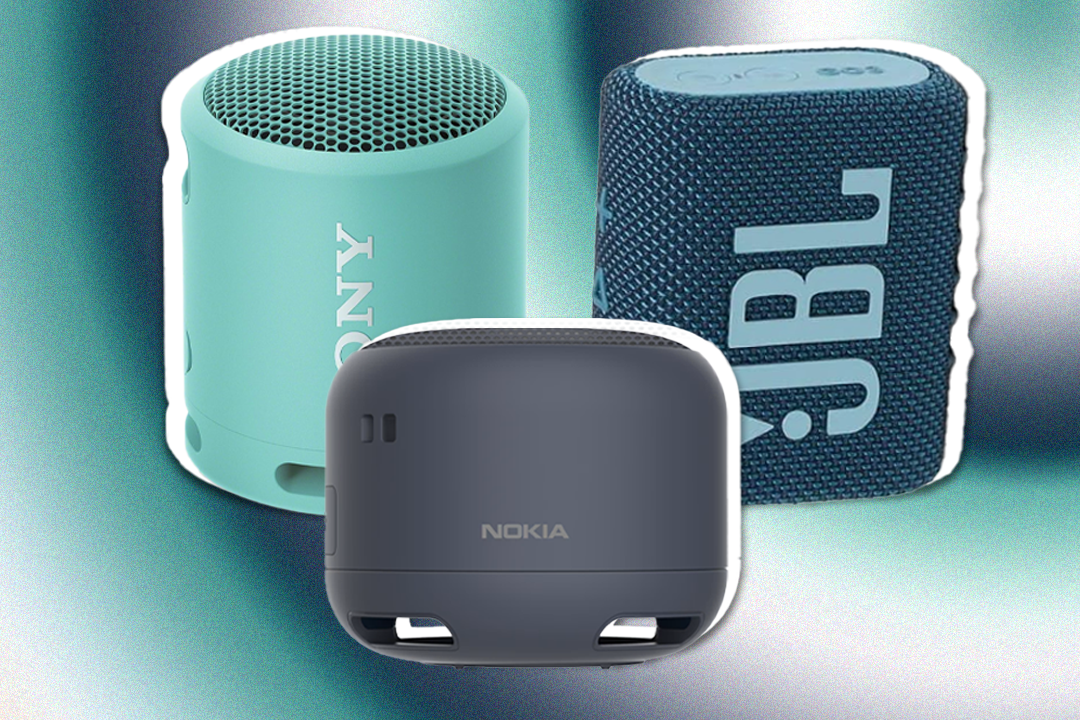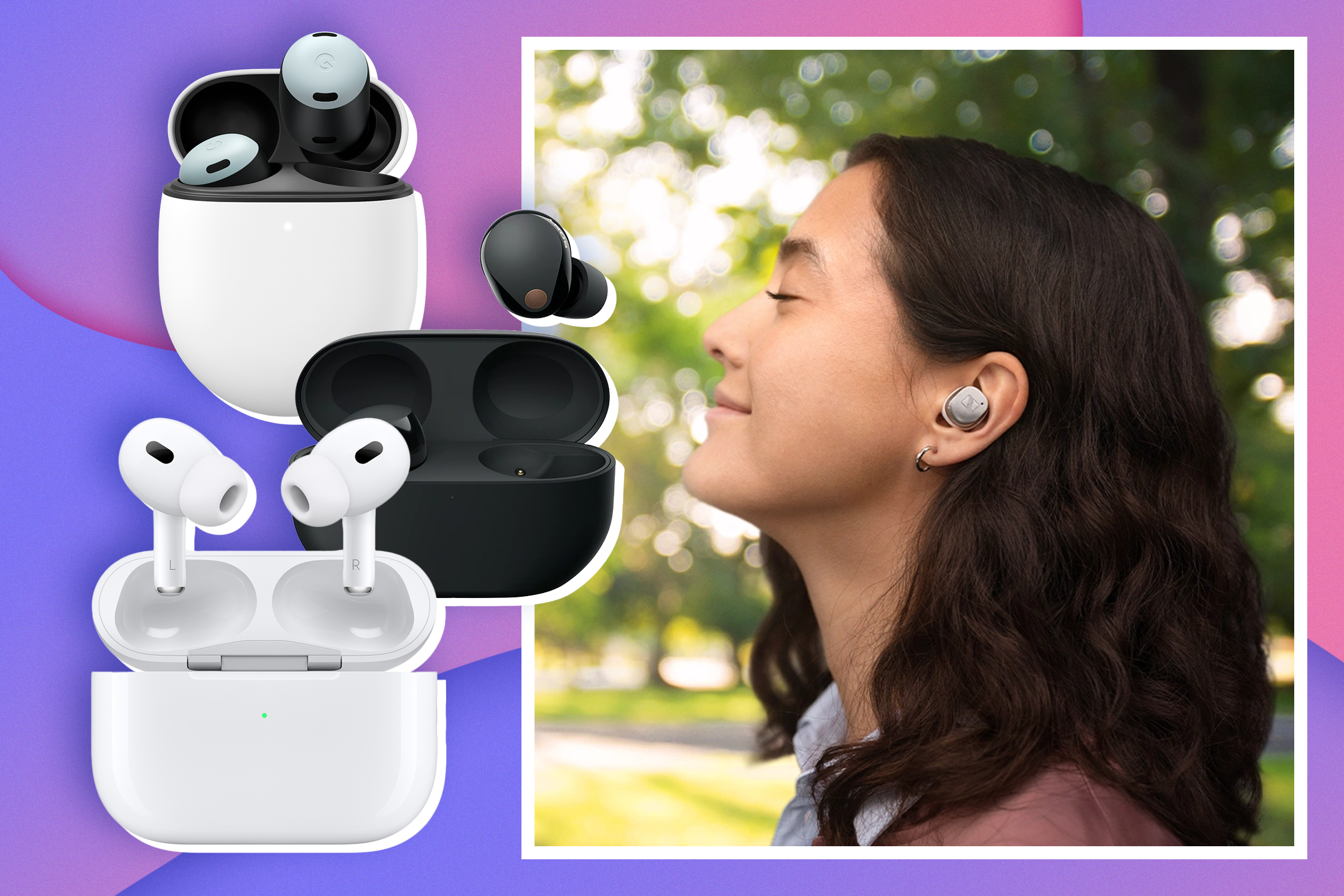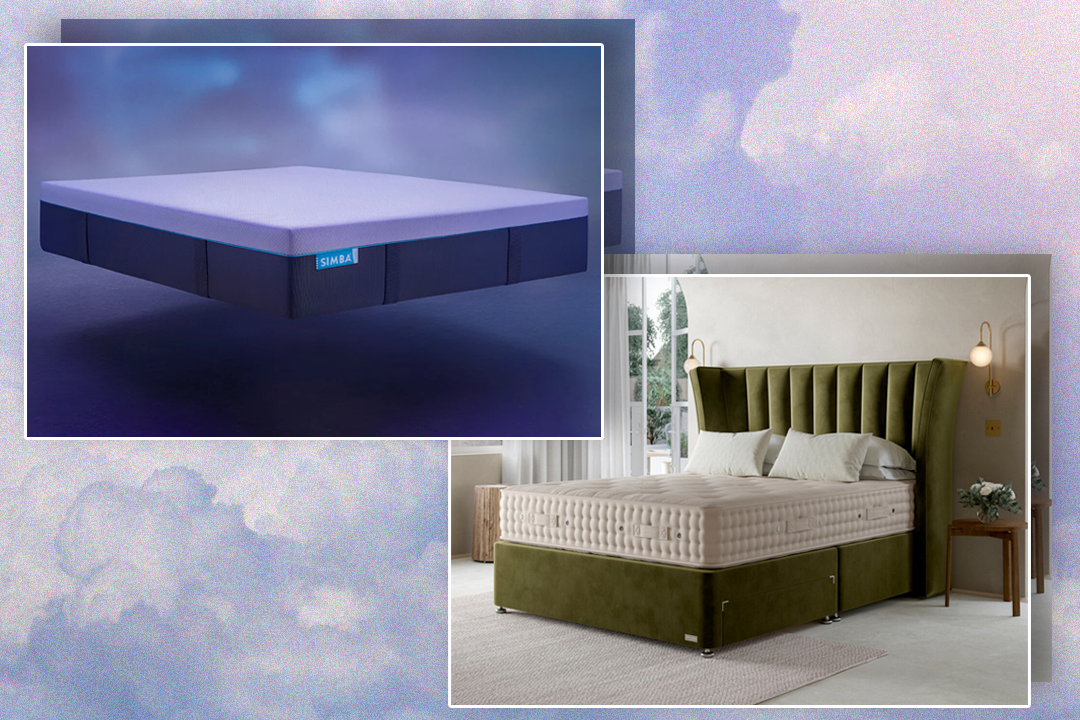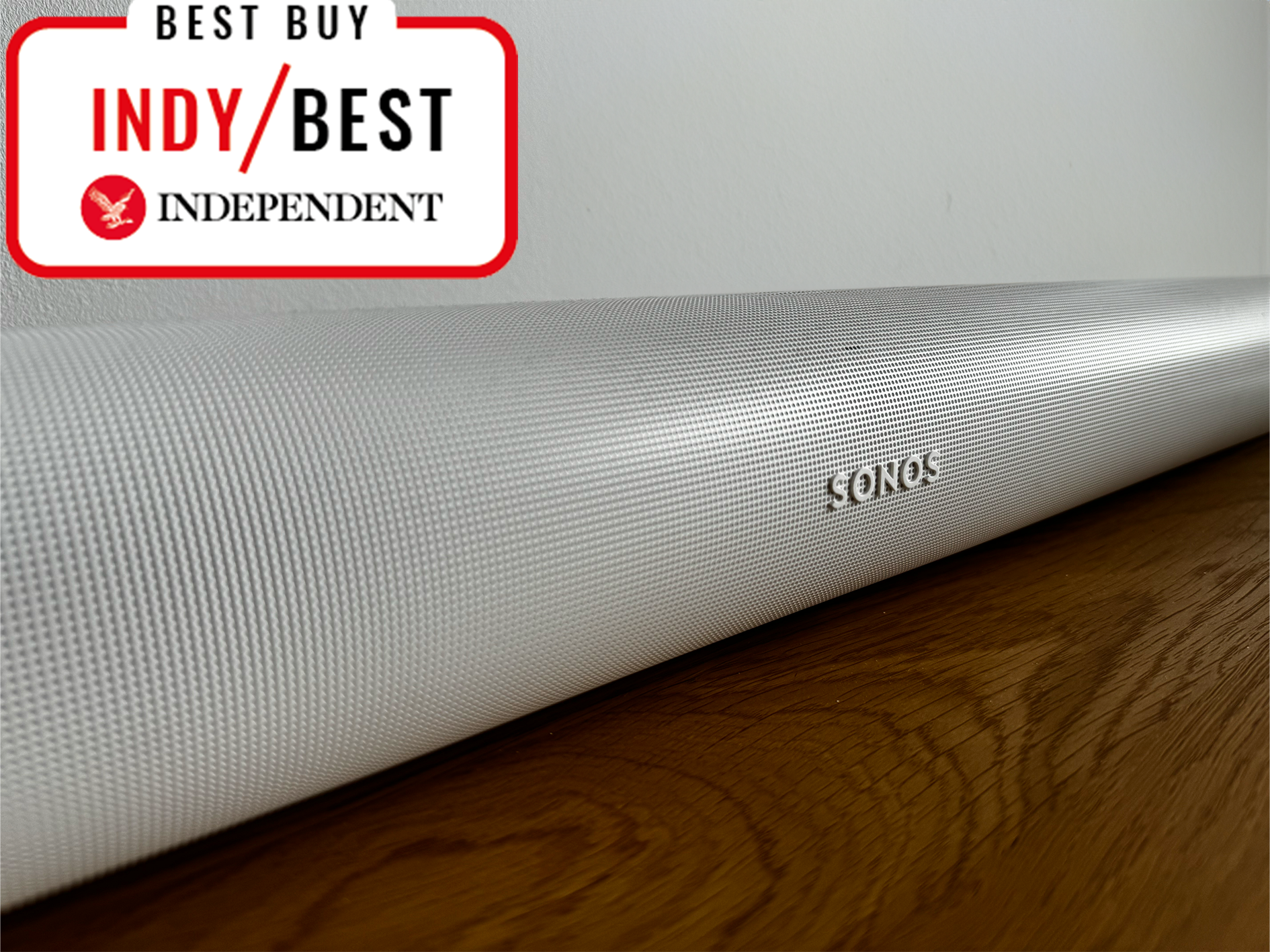
The Independent's journalism is supported by our readers. When you purchase through links on our site, we may earn commission. Why trust us?
11 best soundbars for cinematic audio from your TV
Take your living room audio to new heights, with these quality all-in-one TV speakers

Whether you’re setting up massive 80in TVs for a Marvel marathon or inviting your mates over to watch the football, it’s never been easier to get that silver-screen experience right from the comfort of your own settee. While the picture quality on the telly is getting better and better, audio quality is usually the first to take a hit. That’s where the best soundbars come in.
Those thin screens with marginal bezels leave little room for booming speakers, so, voices don’t always sound crisp and clear, and there’s often not much depth. With a soundbar, you get explosive sound that matches the intense shots seen on screen.
The best part? All that acoustic magic comes in an all-in-one audio box, available in a range of sizes – there are compact examples or beefier ones that stretch across the length of your TV, and everything in between.
You can get soundbars that connect via both ARC (Audio Return Channel) and eARC (Enhanced Audio Return Channel), as well as examples that come with external subwoofers. The latest technology is also making blockbuster audio more immersive than ever before, thanks to the integration of three-dimensional sound technology, courtesy of Dolby Atmos.
As well as giving your favourite TV shows and movies a deeper, richer sound, you can also connect your phone to the models in this article (via Bluetooth) and use the soundbar as a speaker to get the tunes pumping in your living room. Below, you’ll find our pick of the best soundbars for a range of budgets.
How we tested
We looked at a range of different soundbars – from high-end premium models to more budget-friendly options, testing them out extensively on our 65in LG nano86 television set, which has an eARC port.
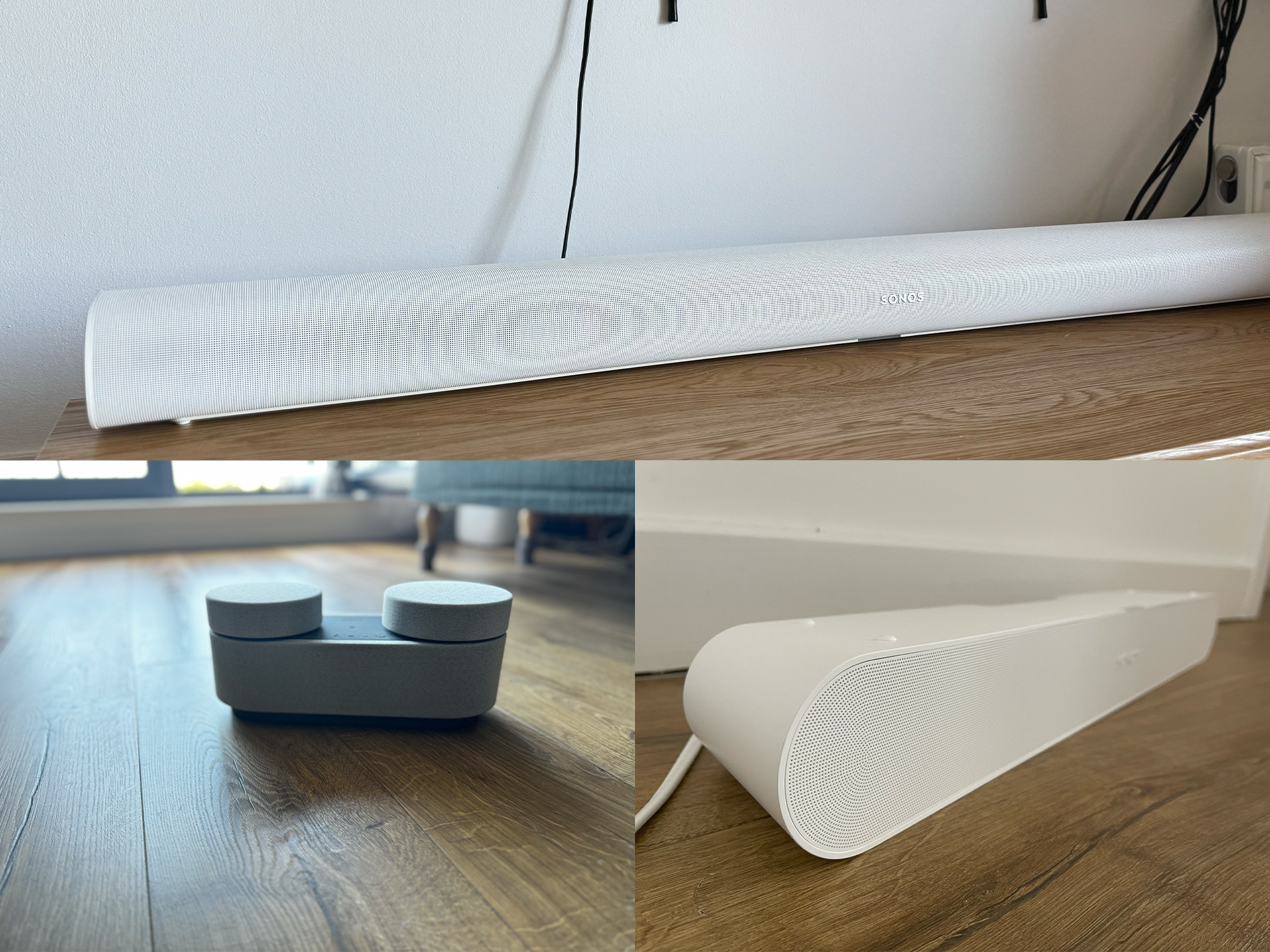
To get a full sense of the soundbar’s audio quality, we watched a range of Dolby Atmos and non-Atmos TV shows and films on Netflix and regular TV, including the Premier League, Altered Carbon, Six Underground and high-fidelity music streaming services.
We also looked at each model’s design, features and specs, looking at the quality of any extras – such as subwoofers and companion apps, as well as assessing each soundbar’s overall performance when it came to filling rooms with sound.
The best soundbars for 2024 are:
- Best overall – Sonos arc soundbar: £694.99, Amazon.co.uk
- Best budget buy – Sharp HT-SB700 soundbar: £175.19, Amazon.co.uk
- Best compact design – Sonos beam, gen 2: £381.37, Amazon.co.uk
- Best Alexa-enabled soundbar – Denon home sound bar 550: £499, Amazon.co.uk
- Best for streaming – Roku streambar: £120, Amazon.co.uk
Sonos arc soundbar

- Best: Overall
- Dimensions: 114cm x 34cm x 11.5cm
- Weight: 6.3kg
- Speaker configuration: 5.0.2
- Connections: Optical, ethernet, wifi, HDMI ARC and eARC, AirPlay 2
- Sound formats: Dolby Atmos, Dolby True HD, Dolby Digital+, Dolby Digital
- Voice assistant: Amazon Alexa and Google Assistant
- Separate subwoofer included: Not included, sold separately
- Why we love it
- Incredible, room-filling sound
- Great Dolby Atmos integration
The Sonos arc is a beast of a soundbar, in both size and sound. Stretching over 1m in length, this sleek, cylindrical speaker suits bigger living rooms best, but if you’ve got a tinier flat and can fit this big boy in, you will appreciate the spectacular audio quality. It features 11 digital amplifiers – eight separate woofers and three silk-dome tweeters, which fire out in all directions, for a completely immersive Dolby Atmos experience.
Sonos doesn’t bundle in a wireless subwoofer, so the bass might not roar, but if you crank up the volume loud enough, those woofers will still manage to get your heart pumping. In the Sonos app, you also have the ability to run the nifty True Play tuning feature – it blasts a few bleeps as you wave your phone in the air, to perfectly augment the sound to the shape of your room.
We also can’t understate how good the Dolby Atmos integration is, if your TV supports it. The sound really puts you in the middle of a film as the action spins around you, helped along by those upfiring speakers, which give the sound some lovely height. Plus the integration of both Alexa and Google Assistant is extremely welcome. We were, however, disappointed at the lack of HDMI ARC passthrough, so, if you don’t have a TV that supports eARC, you won’t be able to hear Atmos on your Xbox or PS5.
Sharp HT-SB700
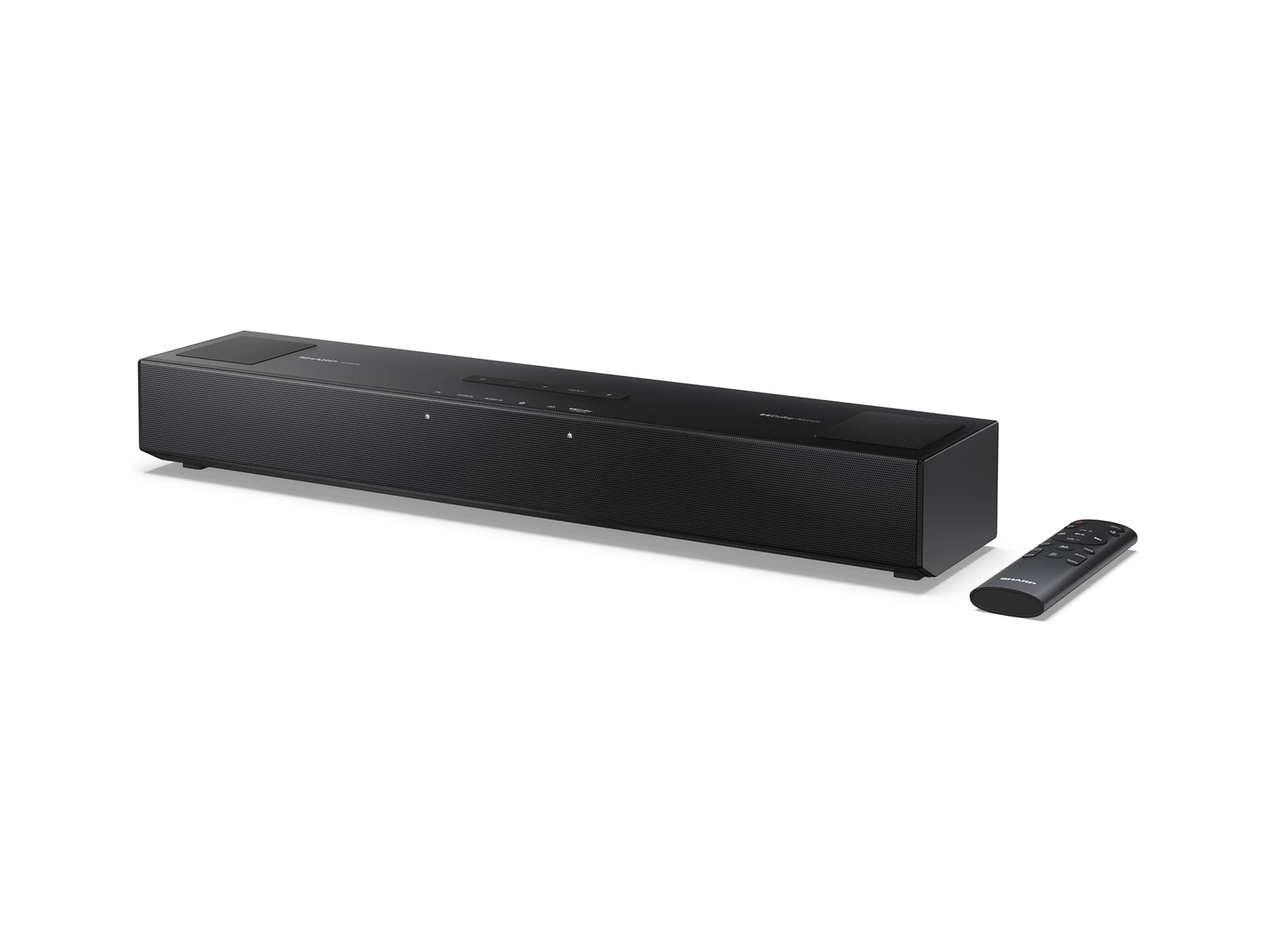
- Best: Budget buy
- Dimensions: 11cm x 52cm x 7.2cm
- Weight: 1.9kg
- Speaker configuration: 2.0.2
- Connections: Optical, HDMI ARC and eARC, Bluetooth 5.3
- Sound formats: Dolby Atmos
- Voice assistant: No
- Separate subwoofer included: No
- Why we love it
- Works with Dolby Atmos content
- Take note
- Not the best-sounding but good for the price
It’s practically unheard of to find a fully specced-out soundbar with Dolby Atmos coming in at less than £200 but Sharp (remember them?) has done it. The Sharp HT-SB700 is only slightly smaller than the Sonos beam, has almost all the same features and is a fraction of the price.
It features two front-firing drivers and two up-firing speakers. Those upward-facing speakers provide the height we’re looking for from our films, making it feel like planes are soaring above our head when watching 6 Underground. Thanks to the inclusion of eARC (extremely rare on budget soundbars), we could use our smart remote to control the volume, and it supported Dolby Atmos.
Atmos content worked really well, with sound feeling like it was coming from all directions, rather than through the centre. You could hear cars zoom across the room, and while the bass was a little lacking (understandable given its size), there was still some strength in the lows.
There’s no app, but you do get a remote control with five pre-sets, including a night mode for when we were watching late at night and didn’t want to disturb anyone, plus easy adjustment of the treble and bass. While it’s not the best-sounding speaker on this list, it’s very good for the price.
Sonos beam, gen 2 soundbar
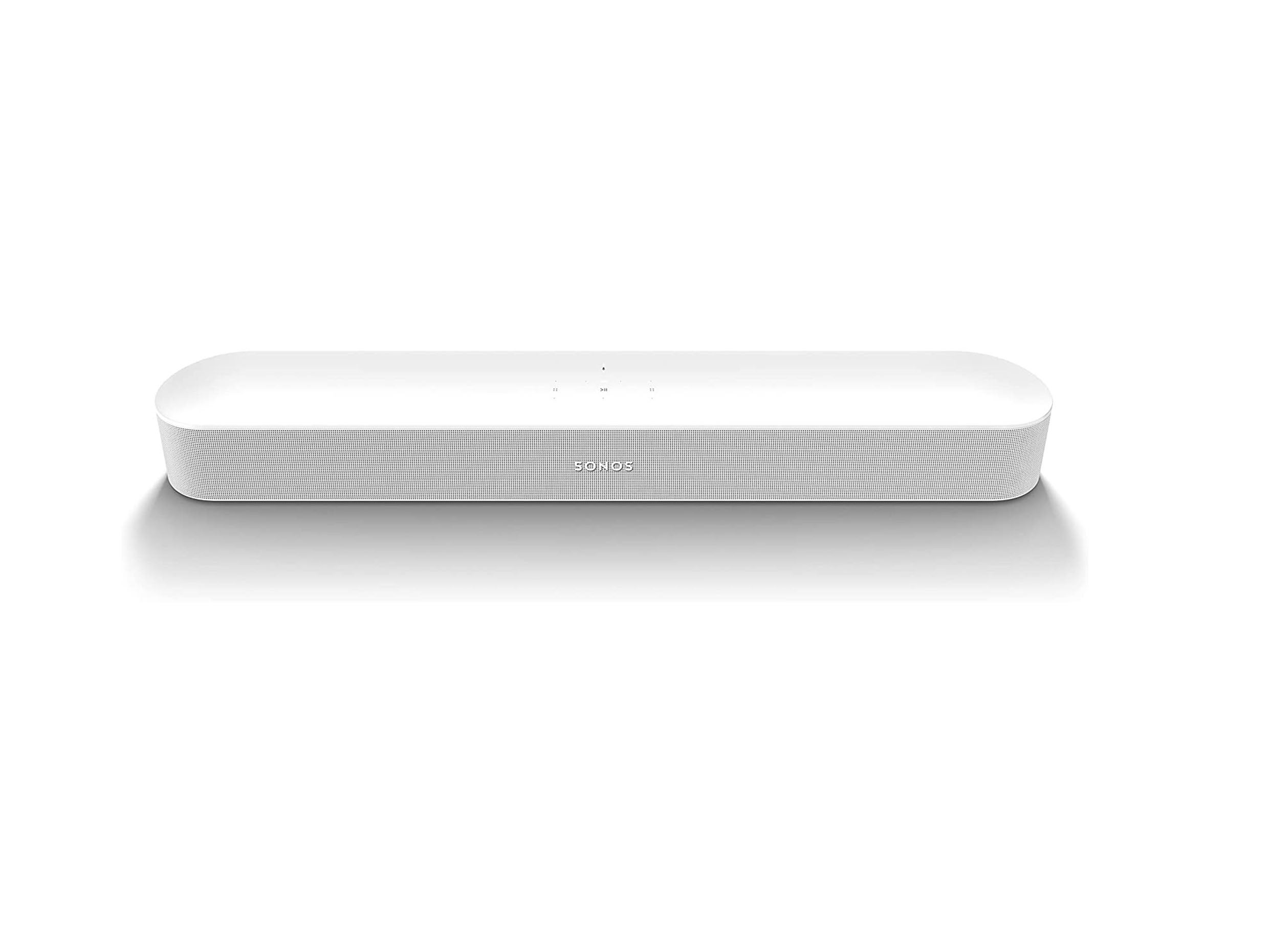
- Best: Compact design
- Dimensions: 65.1cm x 6.85cm x 10cm
- Weight: 2.8kg
- Speaker configuration: 5.0
- Connections: Optical, HDMI ARC/eARC, ethernet, wifi, AirPlay 2
- Sound formats: Dolby Digital, Dolby Digital Plus, Dolby Atmos, Dolby True HD, DTS
- Voice assistant: Alexa and Google Assistant
- Separate subwoofer included: Not included, sold separately
- Why we love it
- Wide soundstage
- Great level of 3D-virtualisation
The second-generation version of the Sonos beam is a lot like the first model. The compact mid-range speaker still sounds great, but it now has a more stylish plastic grill design that brings it in-line with the larger, more premium Sonos arc, as well as bringing onboard Dolby Atmos virtualisation and HDMI eARC support.
The beam soundbar is as sonically impressive as it’s always been. It’s powered by four front-facing elliptical mid-woofers, an improved tweeter in the centre and three passive radiators for the lower, deeper frequencies, all backed up by five amplifiers. What you get is an extraordinarily wide soundstage that feels noticeably expansive.
Although there aren’t any up-firing speakers to give significant height to the Atmos mix, the virtualisation still adds a tangible three-dimensional element to films and music. There’s more depth in the second-gen beam, so, while it can’t compete with the arc, it’s still a brilliant little soundbar. Add in the fact it’s a Sonos product with true play; it has compatibility with all the major music streaming platforms, including high-fidelity tiers; and that it features Alexa and Google Assistant support, we can’t really complain.
Polk Audio react soundbar
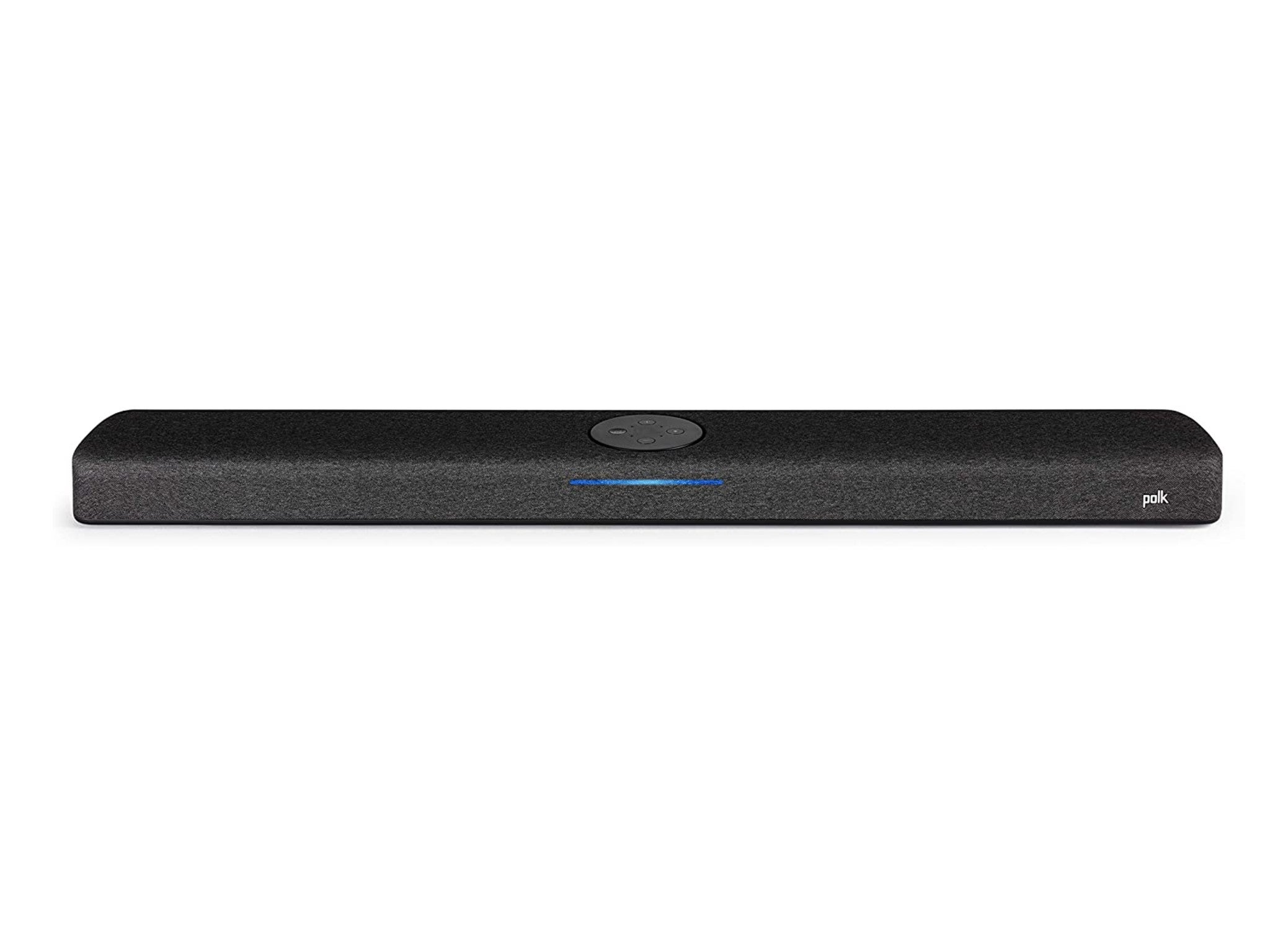
- Best: Entry-level soundbar
- Dimensions: 86.4cm x 5.7cm x 12.1cm
- Weight: 2.9kg
- Speaker configuration: 2.0
- Connections: Optical, HDMI ARC, Bluetooth, USB, wifi
- Sound formats: Dolby Digital, DTS
- Voice assistant: Built-in Alexa
- Separate subwoofer included: No, sold separately
- Why we love it
- Works like an Alexa smart speaker
- No sound distortion at loud volumes
- Nice preset options
- Take note
- No Dolby Atmos support
If you thought you needed to pay out the wazoo for a half-decent soundbar, think again. Polk has designed the perfect entry-level model for those who don’t have a grand lying around to spend on the Sennheiser or B&O options.
It looks surprisingly sleek for its small price tag, completely covered in fabric and with an Echo speaker plonked in the middle. It literally works like an Alexa smart speaker, meaning you can connect it with your other Amazon Echo speakers for a true multi-room experience. It was also pretty good at picking up the sound of our voice from a fair distance away, thanks to its four far-field microphones.
Although there’s (understandably) no Dolby Atmos support, audio on the react is still of a commendable performance for those simply wanting to upgrade their TV’s speaker setup. It doesn’t really go beyond the boundaries of its miniature dimensions, but the sound you do get is clear, precise and sharp, with no real distortion when there are significantly low or high frequencies blaring out. The audio presets on the remote can help on occasion, and dialogue can be boosted by the voice-adjust function if needed.
Sennheiser ambeo soundbar
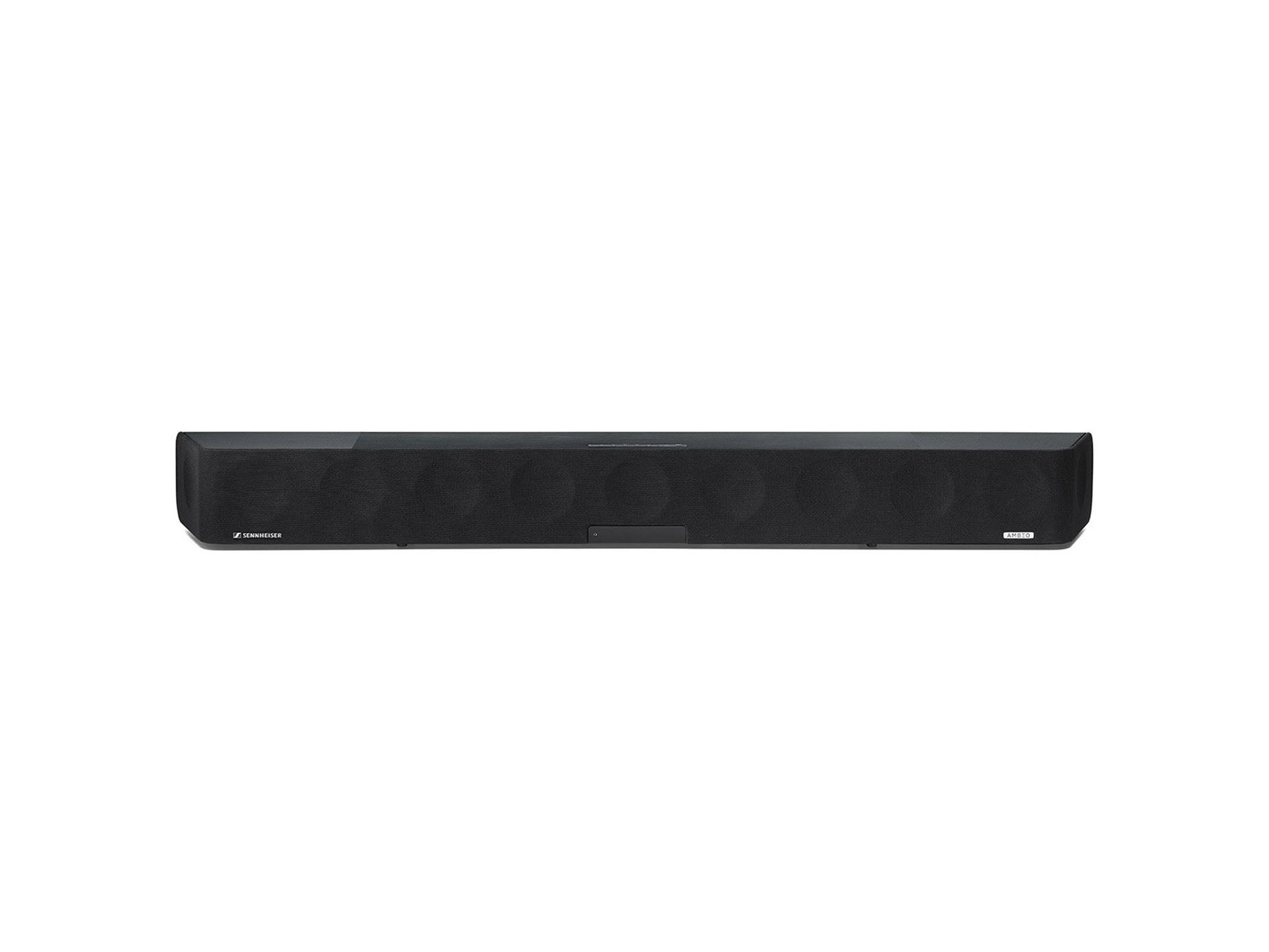
- Best: Premium soundbar
- Dimensions: 126.5cm x 13.5cm x 17.1cm
- Weight per bar: 18.5kg
- Speaker configuration: 5.1.4
- Connections: Optical, ethernet, wifi, 3x HDMI 2.0 input, HDMI eARC, AUX in, USB, mic 2.5mm jack, subwoofer pre-out, Chromecast, Bluetooth, media UPnP
- Sound formats: Dolby Atmos, Dolby True HD, Dolby Digital, Dolby Digital Plus, DTS, DTS:X
- Voice assistant: No
- Separate subwoofer included: No
- Why we love it
- Depth, height and scale from the sound
- Room-filling sound
Five years after its release, the Sennheiser ambeo soundbar still reigns supreme as one of the beefiest, best-sounding all-in-one soundbars around, and still takes the top spot as the most expensive soundbar we’ve ever tested.
Famous for its headphones, the ambeo remains the only speaker that Sennheiser has made, and it delivers an exceptional home audio system experience from one (very hefty) box. It’s big, but there’s a reason why. Unlike more compact soundbars, which pack in smaller drivers, the ambeo accommodates six 10cm woofers, five 25mm tweeters and two 9cm upward-firing full-range drivers – those are big, and without them you wouldn’t be getting such unrivalled, room-filling sound.
There is scale, depth and height when watching a Dolby Atmos film, with dialogue coming across clearly while being precisely centralised. As cars zoom across the screen and the blades of a helicopter swirl towards the ceiling, you’re brought along on the journey. It’s all recreated beautifully by the up-firing speakers. The sound doesn’t just beam outward to the side and upwards but flits seamlessly across the room. It’s an incredibly cinematic experience for a one-box package.
Everything can be controlled from the remote, and there is an abundance of features – from nifty sound profiles like movie mode and night mode to an endless series of connections and Chromecast support. The downside? You’ll need some deep pockets for this soundbar, but if you have them, it’s totally worth it.
Panasonic SC-HTB01 soundslayer

- Best: For gaming
- Dimensions: 43.1cm x 5.2cm x 13.2cm
- Weight: 1.8kg
- Speaker configuration: 2.1
- Connections: Optical, HDMI input, HDMI ARC, 4K HDMI passthrough, Bluetooth, USB (for firmware updates)
- Sound formats: Dolby Atmos, DTS:X, DTS Virtual:X
- Voice assistant: No
- Separate subwoofer included: No support
- Why we love it
- Nifty sound profiles for different game genres
- Slots nicely under a monitor
This tiny soundbar from Panasonic doesn’t look like much with its cloth-covered exterior and miniature size, but it’s a surround sound powerhouse when it comes to desktop gaming, slotting neatly underneath any monitor.
Inside, you’ll find two full-range drivers and two tweeters. It’s a nifty 2.1 soundbar that does well at filling a room during intense gaming sessions, with orchestral game soundtracks and rippling bullets sounding epic and full.
The soundslayer has been designed in collaboration with Final Fantasy 14’s sound engineers, who lent a helping hand with the three gaming sound profiles – RPGs, shooters and enhanced dialogue. If you’re not using one of the gaming presets, there are also the cinema, music and standard sound profiles for when you’re listening to your favourite tunes or watching a spot of Netflix.
While there isn’t any Alexa or Google Assistant integration, you can still connect your phone to the soundbar using Bluetooth if you want to play your music through it.
Denon home soundbar 550
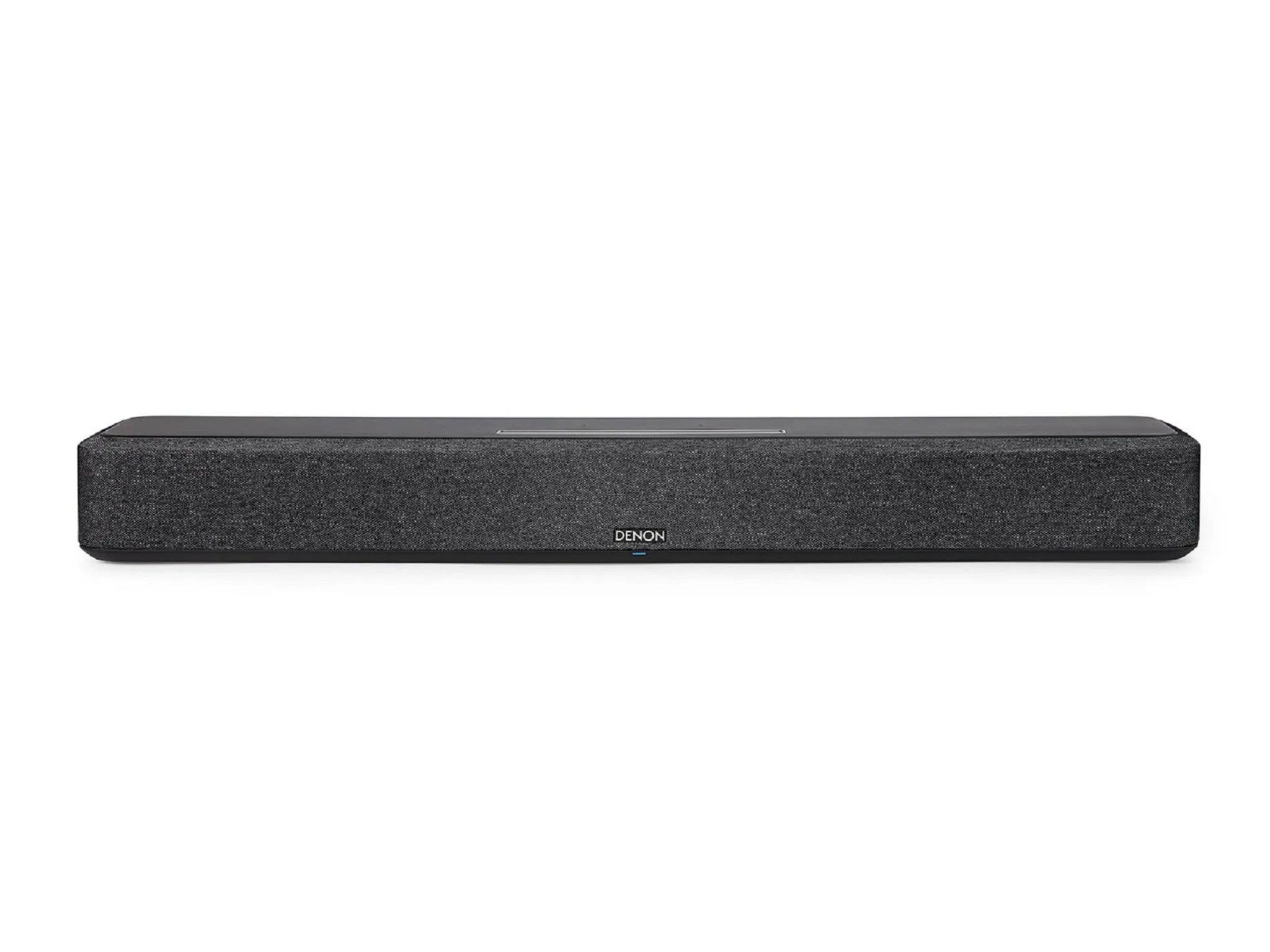
- Best: Alexa-enabled soundbar
- Dimensions: 65cm x 7.5cm x 12cm
- Weight: 3.5kg
- Speaker configuration: 4.0
- Connections: Optical, ethernet, wifi, HDMI ARC and eARC, HEOS, USB, Bluetooth, AirPlay 2
- Sound formats: Dolby Atmos, DTS:X
- Voice assistant: Alexa
- Separate subwoofer included: Not included, sold separately
- Why we love it
- Can be connected to your HEOS system
- Rich, clear audio
- Take note
- Doesn’t get as loud as we’d like
This soundbar from Denon might look cute and small, but it sure sounds mighty, and it is also packed with features. There’s built-in Alexa integration, so you can ask it the weather, set reminders and turn up the volume just with the power of your voice, as well as support for HEOS – Denon’s own proprietary music-streaming system.
If you’re already firmly integrated into the Denon HEOS ecosystem, and have other Denon speakers dotted around your house, you will be able to connect them all up together and play audio in multiple rooms. While the 550 does come with an IR remote, you can control it from the touchscreen on the bar itself if you lose it behind the couch, and you will need to connect to HEOS via the rear of the soundbar on set up. The HEOS app also lets you switch between differing Dolby Atmos modes.
Inside are two tweeters, four full-range speakers and three passive radiators. It’s not the loudest of soundbars, but the audio is rich and clear, with no distortion or muzzling of those low frequencies. Plus the high and mid-frequencies sound full, making it ideal for films and prestige television. You get a range of different presets, including movies, music and pure, with buttons for increasing and decreasing bass and treble.
While the sound won’t get very deep – you won’t feel yourself shaking in your seat, for example – we still appreciate how balanced and neutral it is.
Sonos ray
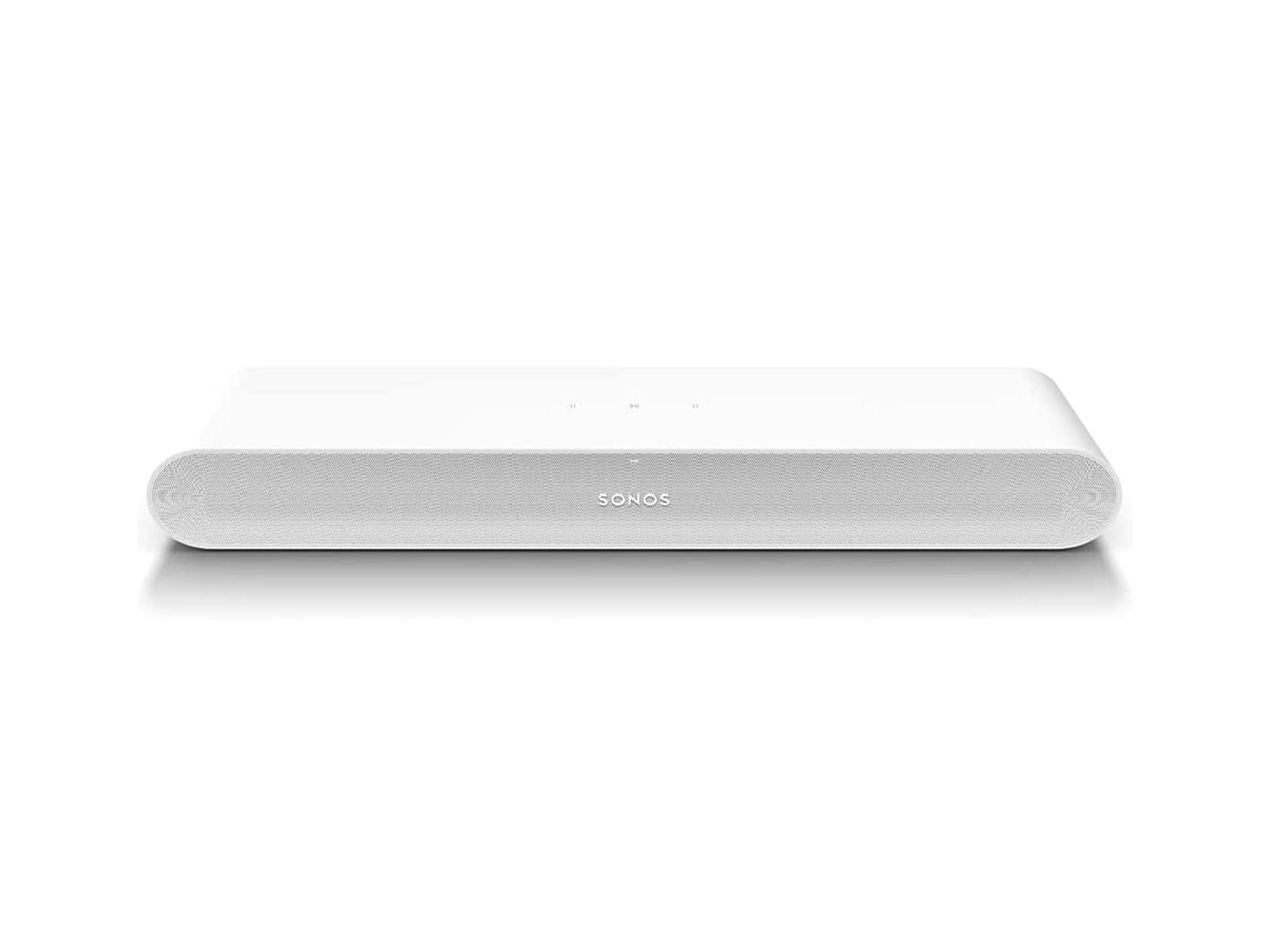
- Best: Budget Sonos soundbar
- Dimensions: 7.1cm x 55.9cm x 9.5cm
- Weight: 1.95kg
- Speaker configuration: 3.0
- Connections: Optical, ethernet, wifi, AirPlay 2, Spotify Connect
- Sound formats: Dolby Digital, DTS Surround, Stereo PCM
- Voice assistant: No
- Subwoofer included: No, sold separately
- Why we love it
- Really good music clarity
- Boosts the sound of dialogue really well
- Nice design
- Take note
- Can only be connected using optical cable
- No Dolby Atmos support
We can wax lyrical about the Sonos beam gen 2 and the beefy Sonos arc, but they’re both luxury products. In 2022, Sonos launched an entry-level soundbar called the Sonos ray, and it’s a really great little soundbar if you’re just getting into the game.
You’ve got an ethernet port, an optical port and a power outlet on the rear. While all Sonos soundbars are a doddle to set up, the lack of HDMI compatibility, present on the rest of the Sonos soundbar family, makes the Sonos ray more of a hassle than most. Because it has to be connected via an optical cable, we couldn’t control the volume using our Samsung smart remote. The other issue with the optical connection is that you’re limited to stereo PCM, Dolby Digital and DTS sound formats, rather than the more cinematic-sounding Dolby Atmos. But it doens’t matter too much when you’re actually watching a film, sports or listening to music – it all sounds brilliant.
The ray boosted the clarity of people’s speech in films with poor sound mixing, making it easier to understand conversations. This was far better than the speech clarity on our TV’s speakers. Bass wasn’t as heart-thumping as we’d liked, but it handled music really well. A nice starter Sonos soundbar if you want to get into Sonos’s burgeoning ecosystem.
Roku streambar
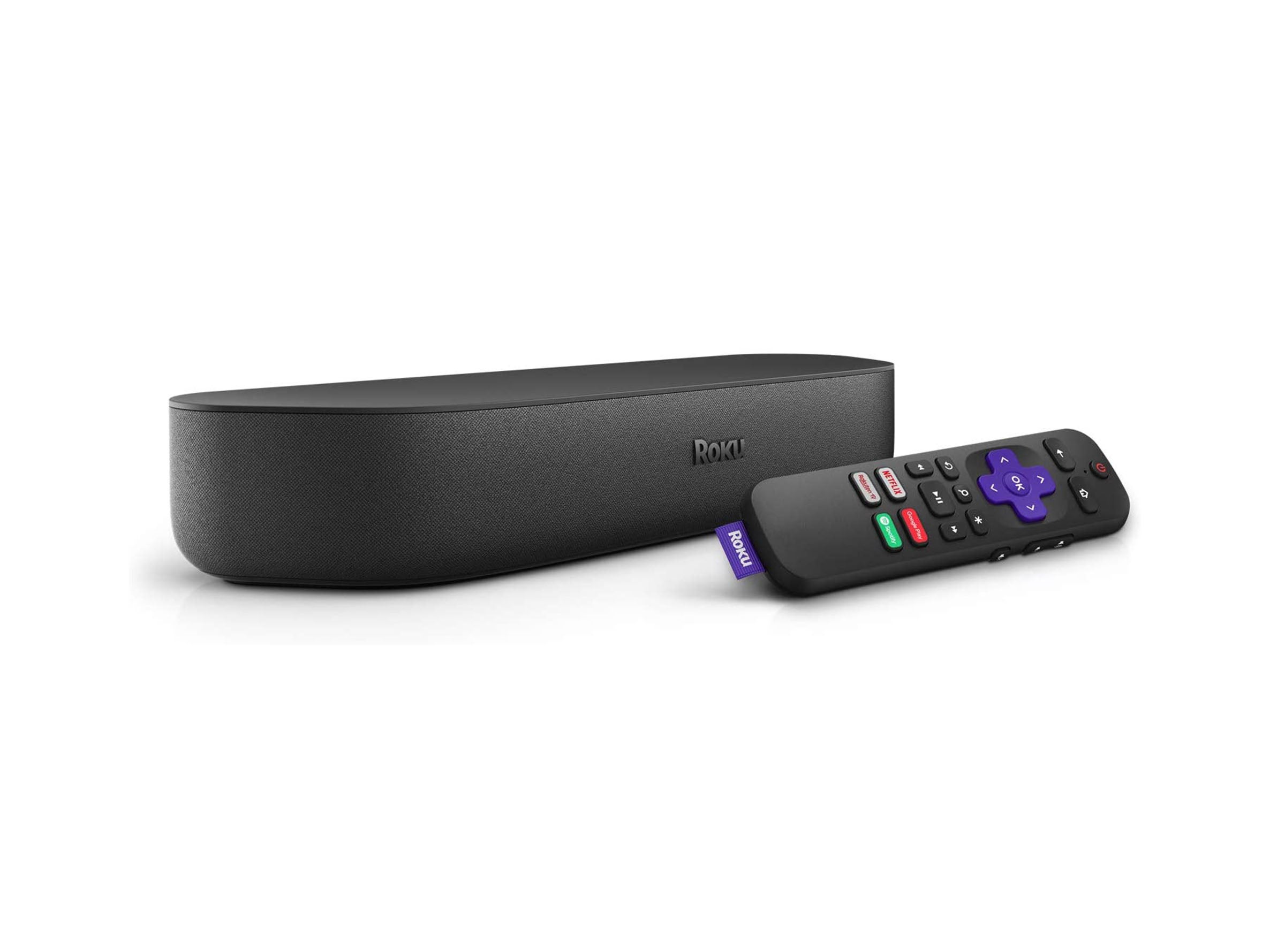
- Best: For streaming
- Dimensions: 35.56cm x 6.09cm x 10.66cm
- Weight: 1.09kg
- Speaker configuration: 2.0
- Connections: Optical, ethernet, HDMI ARC, USB, Bluetooth, AirPlay 2
- Sound formats: Dolby Audio
- Voice assistant: Alexa or Google Assistant
- Separate subwoofer included: Not included, sold separately
- Why we love it
- Integrated Roku support
- Fairly loud and broad sound system
- Take note
- No Dolby Atmos support
This diminutive soundbar from Roku is not so much a compact soundbar as it is a curved soundbrick, which is actually more of a streaming stick, that also happens to enhance your TV audio, too.
The streambar essentially turns your smart TV into an even smarter TV, thanks to Roku OS, giving you access to thousands of apps like Netflix and Prime Video, as well as Apple TV and Spotify, which might not come as standard on your current smart telly. You can also access games, news and more. All of this can be opened and controlled with the Roku voice remote. The streambar supports 4K playback at 60fps and HDR 10.
Don’t let the streaming features fool you though – the sound is good too. For a comparatively low price, you’re not only getting Roku support but a fairly loud and broad audio experience, too, courtesy of two 1.9in forward-facing speaker drivers and two 1.9in side-facing drivers. Although there’s no Dolby Atmos, we didn’t mind too much. Dialogue came across crisp and clear in the stereo mix, and there was some (albeit small) tangible kick to the bass, despite there not being an integrated subwoofer.
Sony HT-AX7
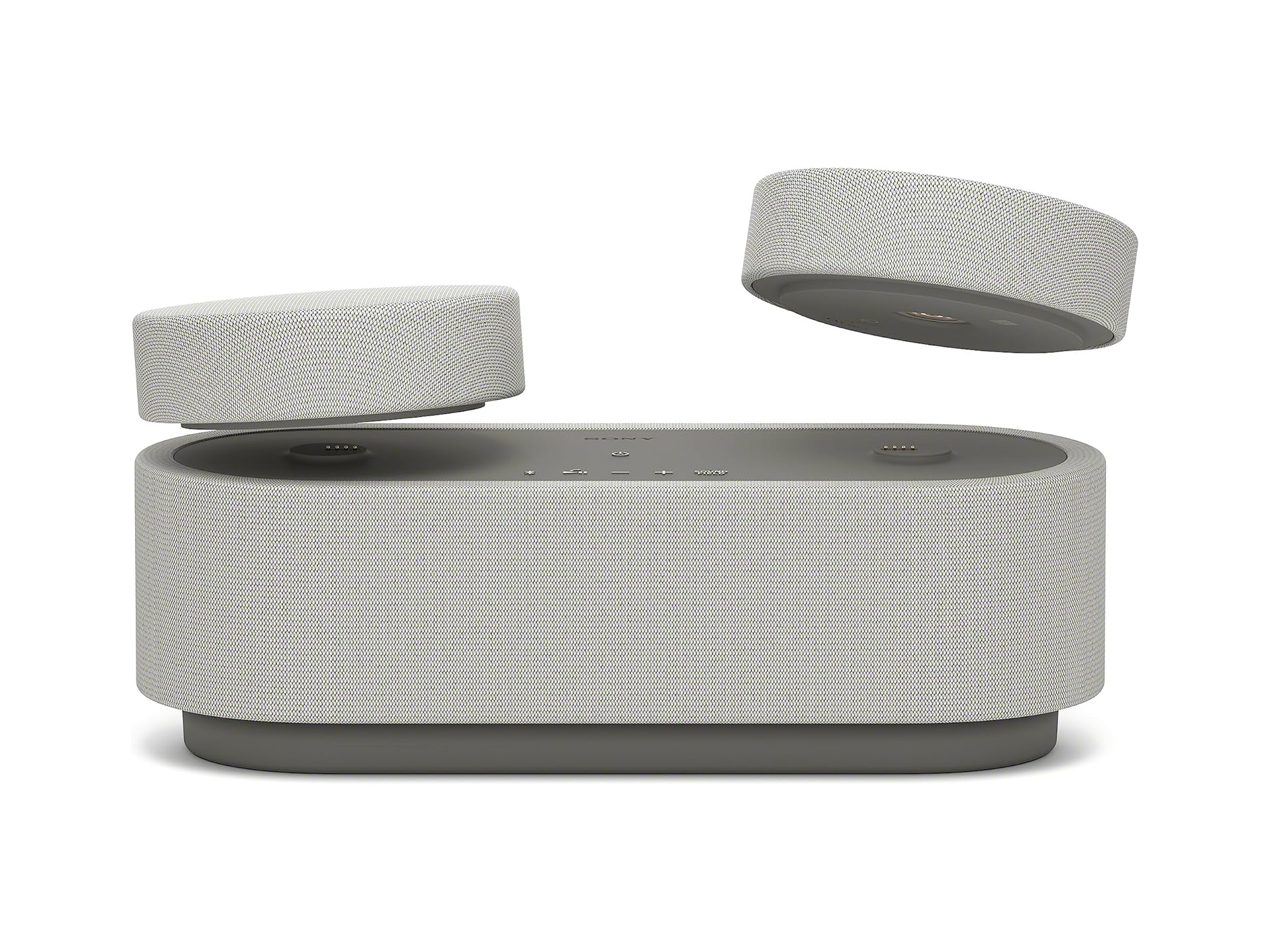
- Best: For portable devices
- Dimensions: Main speaker: 9.7cm x 31cm x 12cm. Speaker discs: 3.9cm x 12cm x 12cm
- Weight: 2kg
- Speaker configuration: 2.0
- Connections: USB-C
- Sound formats: SBC, AAC, 360 Sony Spatial Sound
- Voice assistant: No
- Separate subwoofer included : No
- Why we love it
- Nice design
- Interesting concept
- Really surrounds you in a bubble of sound
- Take note
- No Dolby Atmos
- Quite niche
This is a curious little gadget that essentially gives you a portable soundbar for your tablets and iPads, making it a great travel companion for people who love watching films on their devices abroad but hate their dinky speakers.
Sony’s HT-AX7 is technically a portable surround sound speaker. It looks a bit weird, with one traditional-looking speaker unit and two detachable discs that sit on top. They’re designed so that the discs (which are actually speakers in their own right) can be placed behind you, so you can have a 360-degree audio experience, though this isn’t Dolby Atmos. These disc-shaped speakers charge when put on top of main the speaker.
It was really quite impressive when we placed the speakers in a triangle formation around us, roughly a metre from where we were sitting (as Sony recommends). We placed one on each side table next to the sofa and one on the ottoman bench in front of us, with our laptop on our lap. It kind of surrounded us in the film, with the audio coming from all directions. While it doesn’t support Dolby Atmos, it seemed to do a good enough job with Sony’s 360 Spatial Sound.
It’s a personal home theatre more than anything, as soon as you leave the bubble, you’re going to lose the effect, making it a fairly niche product. But we liked that we could also use the unit as a portable Bluetooth speaker, without having to use the two discs as separate surround sound devices. That makes it a two-in-one speaker and personal soundbar, and we like that Sony is trying something new.
Bang & Olufsen beosound stage
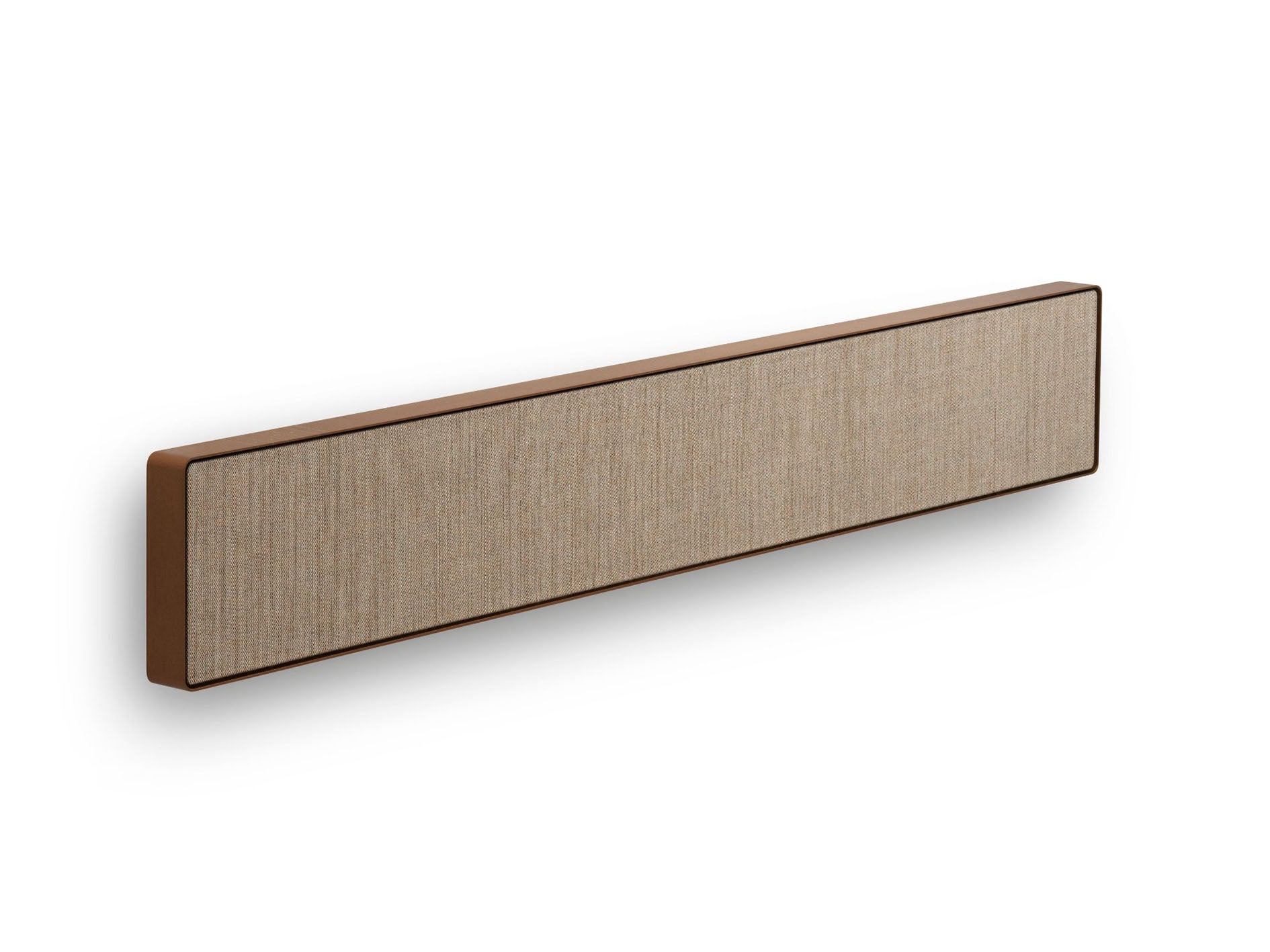
- Best: For movies
- Dimensions: 110cm x 17cm x 7.7cm
- Weight: 8kg
- Speaker configuration: 3.0
- Connections: Ethernet, 3.5mm mini-jack, wifi, HDMI 2.0 input, HDMI eARC, AirPlay 2, Chromecast, 3.5mm Bluetooth
- Sound formats: Dolby Atmos, Dolby True HD
- Voice assistant: No
- Separate subwoofer included: No support
- Why we love it
- Really customisable
- Both dialogue and sound comes across clear and loud
- Take note
- Slightly outdated in terms of specs
This premium soundbar from Bang & Olufsen is a real wonder. The beosound stage is an expensive brushed aluminium beauty with some real oomph in the sound department. Inside, you’ll find 11 speaker drivers, each with its own amplifier, working in harmony to produce a pretty fantastic three-channel sound system.
Everything is controlled through the Bang & Olufsen app. With it, you’re able to optimise the audio based on its position in a room, so you’ll have the same listening experience even if the beosound stage is mounted on the wall or placed on a table. The app includes all the usual sound profiles for movies, music, TV and night listening. These can all be adjusted to your liking. There’s also nifty controls for height channel virtualisation, turning the bass channel off or on and much more – it’s a very customisable machine.
The sound is impeccable, with both dialogue and music coming across clear and loud, and you can easily hear car chases speeding across the room. There’s no subwoofer included – the beosound stage literally doesn’t support one, with B&O promising that the beosound stage doesn’t need one in order to deliver booming bass. And we found that claim to be surprisingly accurate, with some definite thump. Although this is a pretty expensive soundbar, it’s easily one of the best we’ve tested.
Soundbar FAQs
Are soundbars better than speakers?
Soundbars can offer higher-quality audio than speakers while being more compact and neat as there are fewer, if any, wires and cables, especially with those designed to connect to your TV or mobile devices via Bluetooth. They can also often be cheaper than a home cinema speaker system.
Can you mount a soundbar vertically?
To get the best sound quality from your soundbar, it’s recommended to only mount it horizontally, to ensure the sound is spread wider, and to make the multiple woofers and tweeters inside sound strong. Also, installing it vertically can be more difficult and make it less stable.
Are soundbars good for karaoke?
You can use your soundbar for karaoke, however, most don’t have a mic-in option, so you may need a Bluetooth microphone to have the full sing-along experience.
The verdict: Soundbars
The Sonos arc is the real standout here, delivering an epic sonic Dolby Atmos experience in one single package. It looks sleek, has several clever integrations and works brilliantly with both music and films. Looking for the best of the best? You can’t really go wrong with the Sennheiser ambeo, if you’re happy to splurge.
If you’re after a more compact affair, the second-generation Sonos beam and the Denon home 550 are stellar choices. Whatever you go for, investing in a soundbar will elevate your home audio experience to new heights – literally, if you opt for a Dolby Atmos-friendly one.
To get all your printing needs sorted, try one of the best home printers
